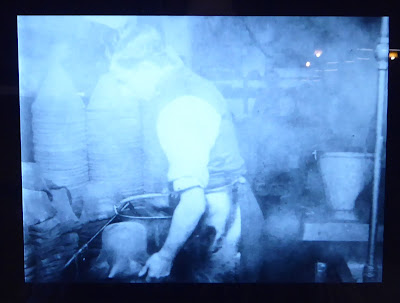 |
| Finished! |
Mistakes and unpicking continued to the end, but did lessen as I established a process. Once I understood it properly, the pattern was actually quite straightforward. The wrong side rows are just knit and purl with no increases or decreases, so in effect they are 'rest rows'. The 22 rows of the pattern are repeated throughout, with the motif section knitted an increasing number of times in each repeat.
I came across these lovely stitch markers from Rebecca's Room, which come in different colour combinations in each set. They were ideal for colour-coding each section of the pattern, so that I always knew where I was in a row. Also, I got into the habit of counting my stitches at the end of each section, which meant that I never had more than 22 stitches to undo when I did go wrong.
 |
| Sections separated with different markers |
There were a couple of occasions when I started knitting the wrong row, but fortunately noticed in time. Juliana of Urban Simplicity, who is both a talented knitter and kindly generous with her knowledge, suggested a couple of ways to avoid this pitfall and, thanks to her, I remembered that I have this chart holder. It's a sheet of steel with magnetic strips, which you arrange to highlight the section you are working from.
 |
| Highlighting the row I'm working on |
I had no idea how much of the shawl I would be able to knit with the wool I was using, but had the idea to weigh the ball after 64 rows and again after 72 rows. I then knew that I had used five grams, and knitted 1,112 stitches, so approximately 222 stitches per gram. I kept weighing the ball as I worked, and it averaged out at around 240 stitches per gram. When I was getting towards the end of the pattern as written I still had quite a lot of wool left, and was able to calculate that I had enough for an extra (sixth) row of motif, so that was what I did.
As it turned out, I would have had enough wool to have done the whole shawl in blue, but having knitted the centre section in black I stuck with my original plan and knitted the edging in black as well. It was a new type of bind-off for me (knitting through the back of the loops), so I practised with some spare wool first.
I must admit that once the piece was off the needles, it didn't look very impressive.
 |
| On a single blocking mat, for scale |
But thanks to the magic of blocking, it was transformed.
 |
| Blocking still feels akin to magic to me! |
The finished shawl came out slightly smaller than the pattern (measured at the row of five motifs) presumably due to using a different wool. I think that I may have been slightly over-aggressive in the blocking, as it seems a bit more holey than the photos of the original, but it's possible that the correct wool is a bit fluffier.
Unfortunately, while it was actually sunny when I came to take pictures this afternoon it was also absurdly windy, so I had to work indoors. Looking at the photos, I am glad that I went for the black edging as it adds contrast. All in all, I'm really pleased with the end result, and am delighted to have added lacework to my knitting repertoire.
 |
| Showing the back centre and edging |
 |
| Arranged to show the centre 'spine' |
 |
| Trying, and failing, to take photos outdoors |
At some point, I may have to add a 'knitting gallery' page to this blog. Who would have thought it?
















































